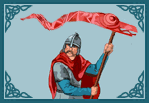 |
 |
|||
|
|
Constantine was perhaps the eldest surviving son of the British Emperor, Magnus Maximus. Little is known of him for sure, but there are indications that he probably ruled one of the post-Roman divisions of Wales, like his brothers. Constantine lived at a time when the Roman administration was breaking down. With the collapse of his father's play for Imperial power in AD 387, he and his brothers took control of his late powerbase in Wales, apparently dividing it up between them. Antonius took the South-West and Eugenius, the South-East. What title they used is unknown. They would not have called themselves kings. Perhaps they were something like provincial governors. Publicus had entered the church and had no interest in government. But where did Constantine hold sway? The obvious place to look is in Northern Wales. We know that later, in the time of Cunedda Wledig (early 5th century), what was by then called Gwynedd was fully controlled by Irish invaders. But previously, Caer-Segeint (Caernarfon), the chief city in the area, was closely associated with Constantine's mother, St. Helena, and her family. We know that his brother, St. Publicus, set up a church adjoining the old Roman fort there and another brother, Eugenius (alias Owain, from South Wales), is said to have died in the area. All indications are that Maximus' family continued to control Gwynedd at the end of the Roman period, before the Irish arrived and swept them aside. One final piece of evidence shows that the local man of authority was almost certainly Constantine and that Caernarfon was his powerbase. A lost stone, which for many centuries stood outside the old Roman fort is recorded by Nennius: "Constantine.....his tomb is shown near the city which is called Caer Segeint, as letters tell which are on the stone of his tumulus". Records of King Constantine date back to at least the 10th century. He could well be historic.
|
|||
| © Nash Ford Publishing 2001. All Rights Reserved. | ||||




